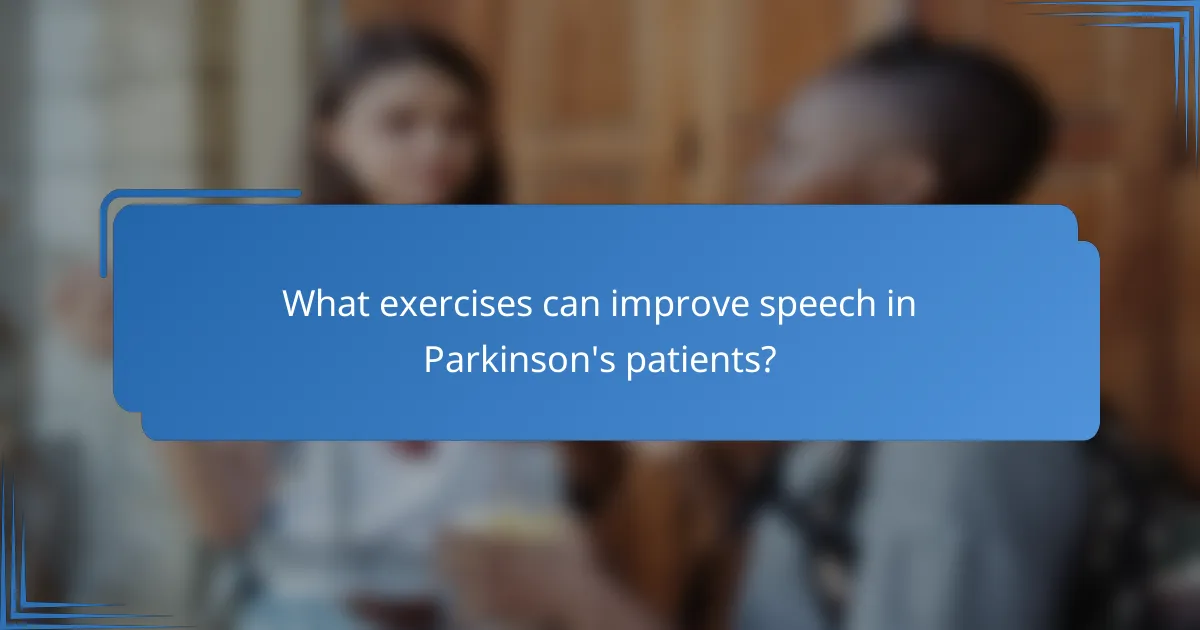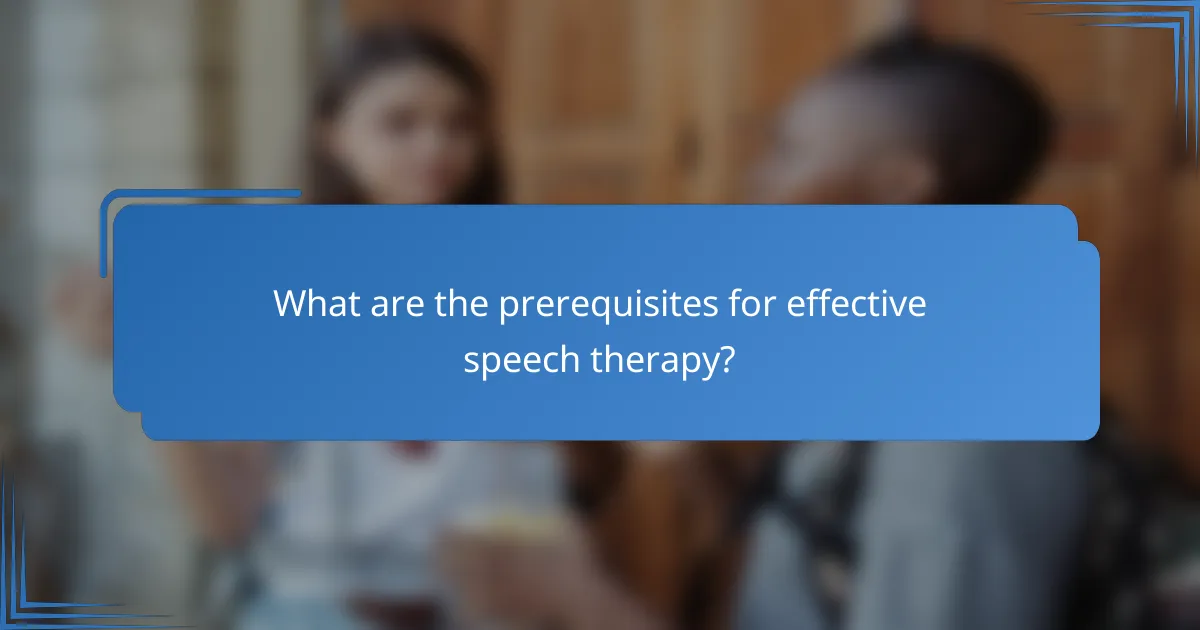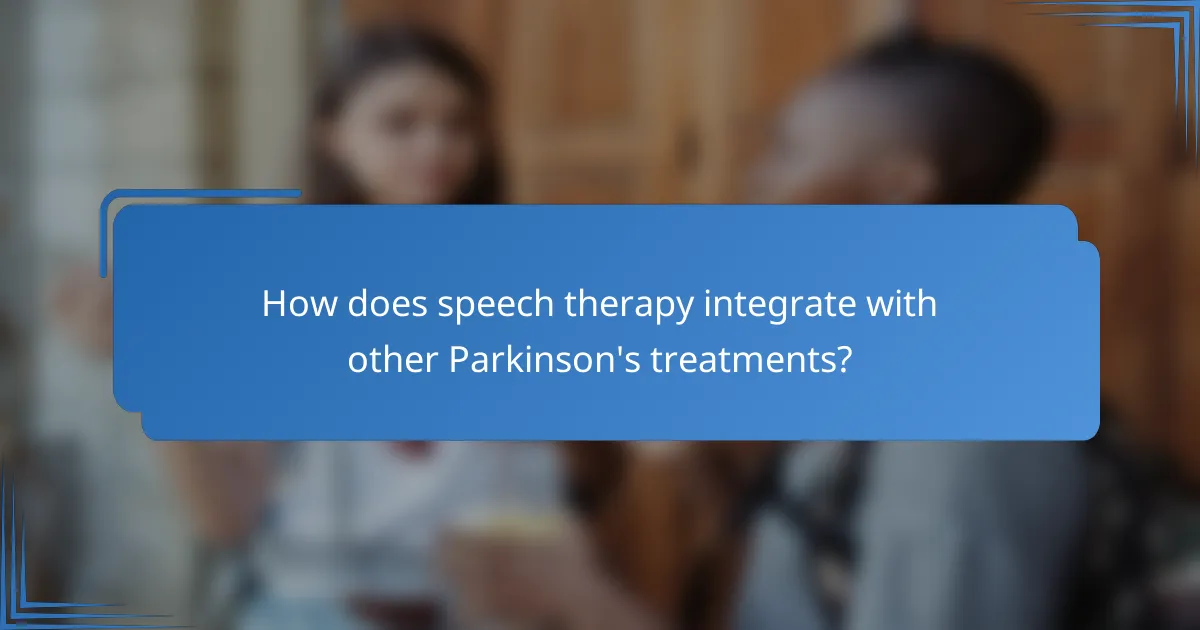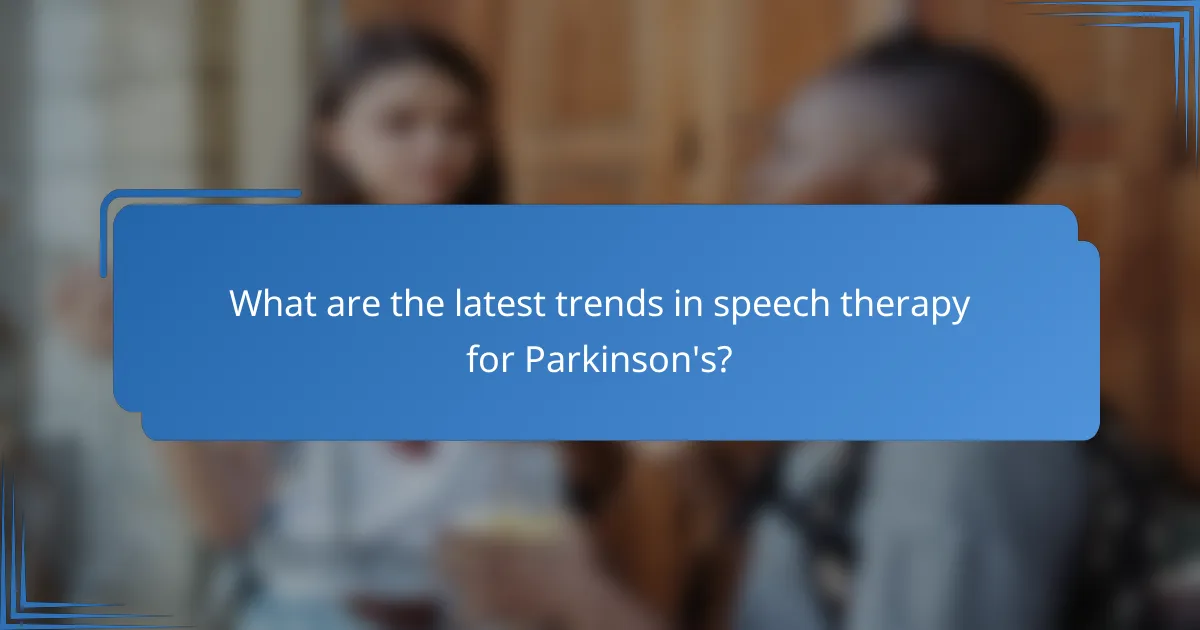Parkinson’s disease can significantly impact communication, making effective speech therapy essential for enhancing clarity and confidence. Tailored exercises and techniques not only improve vocal strength and breath control but also help individuals manage speech difficulties, fostering better interactions with others. By focusing on these communication strategies, patients can experience reduced frustration and increased confidence in their daily conversations.

What are effective communication techniques for Parkinson’s patients?
Effective communication techniques for Parkinson’s patients focus on enhancing clarity and confidence in speech. These methods can help manage speech difficulties commonly associated with the condition, allowing for better interaction with others.
Speech exercises
Speech exercises are essential for improving vocal strength and clarity in Parkinson’s patients. Techniques such as vocal warm-ups, pitch variation, and articulation drills can help enhance speech quality. Regular practice, ideally daily, can lead to noticeable improvements over time.
Some effective exercises include reading aloud, practicing tongue twisters, and using exaggerated mouth movements. These activities can help reinforce muscle control and improve overall communication skills.
Use of technology
Technology can significantly aid communication for individuals with Parkinson’s. Tools such as speech-generating devices and apps designed for voice amplification can enhance verbal interactions. These resources can be particularly beneficial in noisy environments or during group conversations.
Additionally, video calling platforms can facilitate face-to-face communication, allowing patients to engage with family and friends more effectively. Using text-to-speech applications can also provide an alternative way to communicate when verbal expression is challenging.
Group therapy sessions
Group therapy sessions offer a supportive environment for Parkinson’s patients to practice communication skills. These sessions often include guided exercises that focus on speech, listening, and social interaction. Participants can share experiences and strategies, fostering a sense of community and encouragement.
Engaging in group therapy can help reduce feelings of isolation and improve confidence in speaking. Regular attendance can lead to gradual improvements in both speech and social skills, making interactions more enjoyable and effective.

How can speech therapy benefit individuals with Parkinson’s?
Speech therapy can significantly enhance communication for individuals with Parkinson’s by improving their speech clarity, boosting confidence, and reducing frustration during interactions. These benefits stem from tailored exercises and techniques that address the specific challenges faced by those with the condition.
Improved clarity of speech
One of the primary benefits of speech therapy for individuals with Parkinson’s is the improvement in speech clarity. Therapists often employ techniques such as vocal exercises and articulation drills to help patients strengthen their vocal cords and improve enunciation.
Practicing these exercises regularly can lead to noticeable enhancements in how clearly a person speaks, making it easier for others to understand them. Simple techniques like speaking slowly and exaggerating mouth movements can also help improve clarity.
Enhanced confidence in communication
Speech therapy can greatly enhance an individual’s confidence when communicating. As patients see improvements in their speech clarity, they often feel more empowered to engage in conversations without fear of being misunderstood.
Therapists may incorporate role-playing scenarios to simulate real-life conversations, allowing individuals to practice their skills in a supportive environment. This practice can build self-esteem and encourage more frequent social interactions.
Reduction of frustration
Frustration during communication is common among individuals with Parkinson’s due to difficulties in speech. Speech therapy addresses this issue by equipping patients with strategies to manage their speech challenges effectively.
Techniques such as using visual aids or communication devices can help facilitate smoother interactions. Additionally, learning to take pauses and breathe properly can reduce anxiety and make conversations less stressful.

What exercises can improve speech in Parkinson’s patients?
Exercises that enhance speech in Parkinson’s patients focus on vocal strength, clarity, and breath control. These techniques can help mitigate the speech difficulties commonly associated with the condition, improving overall communication abilities.
Vocal warm-ups
Vocal warm-ups are essential for preparing the voice for effective communication. Simple exercises such as humming, lip trills, and sirens can help loosen the vocal cords and improve resonance. Aim for a duration of 5-10 minutes daily to establish a routine.
Incorporating scales or pitch variations can also enhance vocal range and flexibility. Practicing these warm-ups consistently can lead to noticeable improvements in speech clarity and volume.
Breathing techniques
Breathing techniques are crucial for managing breath support during speech. Diaphragmatic breathing, where the abdomen expands rather than the chest, can provide better control and projection of voice. Spend a few minutes each day practicing this technique to strengthen the respiratory muscles.
Consider using a timer to practice extended exhalations, which can help increase lung capacity. A common exercise is to inhale for a count of four, hold for four, and exhale for six, gradually increasing the exhalation time as strength improves.
Articulation drills
Articulation drills focus on improving the clarity of speech sounds. Repeating specific sounds, syllables, or phrases can enhance muscle coordination in the mouth and tongue. Start with simple sounds and gradually progress to more complex phrases.
Using a mirror during practice can help monitor mouth movements and ensure correct articulation. Aim for short sessions of around 10 minutes, several times a week, to reinforce these skills effectively.

What are the prerequisites for effective speech therapy?
Effective speech therapy requires a thorough understanding of the individual’s specific communication challenges and needs. Key prerequisites include an assessment by a qualified speech-language pathologist and the establishment of personalized therapy goals tailored to the individual’s condition.
Assessment by a speech-language pathologist
An assessment by a speech-language pathologist (SLP) is crucial for identifying the specific speech and communication difficulties associated with Parkinson’s disease. This evaluation typically involves a series of tests and observations to assess speech clarity, voice quality, and language comprehension.
During the assessment, the SLP will gather information about the individual’s medical history, current symptoms, and any previous therapies. This comprehensive approach ensures that the therapy plan is based on accurate and relevant data, which can significantly enhance its effectiveness.
Personalized therapy goals
Setting personalized therapy goals is essential for addressing the unique communication needs of each individual with Parkinson’s. These goals should be specific, measurable, achievable, relevant, and time-bound (SMART), allowing for clear tracking of progress.
Examples of personalized goals may include improving speech volume, enhancing articulation, or increasing the ability to initiate conversation. Regularly reviewing and adjusting these goals in collaboration with the SLP can help maintain motivation and ensure that the therapy remains aligned with the individual’s evolving needs.

How does speech therapy integrate with other Parkinson’s treatments?
Speech therapy plays a crucial role in the comprehensive treatment of Parkinson’s disease by enhancing communication skills and addressing speech-related challenges. It often works in conjunction with other therapies to provide a holistic approach that improves overall quality of life for patients.
Collaboration with occupational therapy
Speech therapy and occupational therapy often collaborate to address the daily challenges faced by individuals with Parkinson’s. While speech therapy focuses on communication and swallowing, occupational therapy helps patients develop strategies to manage daily activities and maintain independence.
For example, an occupational therapist may work on fine motor skills that complement the speech therapist’s efforts to improve verbal communication. This integrated approach ensures that patients receive support tailored to their specific needs, enhancing both speech and functional abilities.
Complementary physical therapy
Physical therapy complements speech therapy by addressing the physical aspects of Parkinson’s that can impact communication, such as posture and breath control. Improved physical strength and coordination can enhance the effectiveness of speech exercises, leading to better outcomes.
For instance, physical therapists may incorporate exercises that strengthen core muscles, which can improve breath support for speech. Patients are encouraged to engage in regular physical activity, as it not only supports speech therapy goals but also contributes to overall well-being.

What are the latest trends in speech therapy for Parkinson’s?
Recent trends in speech therapy for Parkinson’s focus on personalized approaches, technology integration, and evidence-based techniques. These methods aim to enhance communication skills and improve the quality of life for individuals with Parkinson’s disease.
Communication techniques
Effective communication techniques for individuals with Parkinson’s often include strategies like voice amplification, clear articulation, and the use of visual aids. Techniques such as the Lee Silverman Voice Treatment (LSVT) emphasize loud speech and vocal exercises to improve clarity and volume.
Additionally, utilizing conversational techniques, such as maintaining eye contact and minimizing background noise, can significantly enhance interactions. Practicing these techniques regularly can lead to more effective communication in daily situations.
Therapy benefits
Speech therapy offers numerous benefits for those with Parkinson’s, including improved speech clarity, better swallowing function, and enhanced social interaction. Regular therapy sessions can help maintain cognitive function and reduce feelings of isolation.
Moreover, engaging in speech therapy can lead to increased confidence in communication abilities, which is crucial for maintaining relationships and participating in social activities. Patients often report a greater sense of control over their speech and overall well-being.
Exercises
Exercises for speech therapy in Parkinson’s typically include vocal warm-ups, pitch exercises, and breath control techniques. Simple practices like reading aloud or singing can also be beneficial in strengthening vocal cords and improving speech patterns.
Incorporating daily exercises, such as tongue twisters or sustained vowel sounds, can help reinforce the skills learned during therapy sessions. A consistent routine is essential for maximizing the effectiveness of these exercises and achieving long-term improvements.
